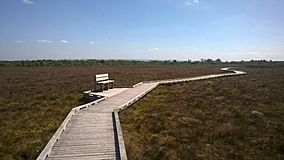Clara Bog facts for kids
Quick facts for kids Clara Bog |
|
|---|---|
| Irish: Dúlra Phortach Chlóirthigh | |

Walkway in Clara Bog
|
|
| Location | County Offaly, Ireland |
| Governing body | National Parks and Wildlife Service |
| website | |
| Designated: | 6 December 1988 |
| Reference #: | 415 |
Clara Bog is one of the biggest and most complete raised bogs left in Ireland. It is located in County Offaly. You can find it between the village of Ballycumber and the town of Clara.
A large part of Clara Bog is owned by the government. It is managed as a special nature reserve. This area helps protect important plants and animals.
Contents
History of Clara Bog
How Clara Bog Formed
Clara Bog started forming after the last ice age. It was once a shallow lake. A natural ridge, called an esker, was left behind by melting glaciers. This ridge blocked water from draining away. Over thousands of years, plants grew and died, slowly forming the deep peat layers we see today.
Changes to the Bog
Even though Clara Bog is mostly untouched, it has been changed by people. In the late 1700s, a road was built through the bog. This road and its drains caused parts of the bog to sink. The bog's natural dome shape was also changed. It became two separate domes, one in the west and one in the east.
Saving Clara Bog
In the early 1980s, there were plans to dig up peat from Clara Bog East for factories. But many people, including famous naturalists like David Bellamy, asked the Irish government to protect it.
In 1987, the Irish and Dutch governments agreed to work together. They wanted to manage and restore peatlands. Clara Bog was chosen as a special study area. The industrial digging was stopped, and old drains were blocked. Scientists have studied the bog's plants and water since the ice age. In 1988, Clara Bog became a Ramsar Site. This means it is a wetland of international importance.
World Heritage Status
In 1992, Ireland thought about making Clara Bog a World Heritage Site. This would give it global protection. However, after some years, it was decided that the bog had been too damaged by past peat cutting. So, the plan was withdrawn in 2009.
Peat Extraction for Homes
Traditional Turf Cutting
For hundreds of years, Irish people have cut "turf" (dried peat) from bogs. They use it as fuel to heat their homes. This is a very old tradition.
Protecting the Bog
When Clara Bog became a protected area, new rules were made. These rules were part of the Habitats Directive. They aimed to stop turf cutting in these special areas. However, many people did not want to stop their tradition.
The Irish government allowed "domestic turf-cutting" for ten more years from 1999. This meant people could still cut turf for their own homes. But this cutting still harmed the bog. Talks took place to find new places for turf-cutters. These new sites would be less important for nature. By 2012, some turf-cutters from Clara Bog had moved to a different bog.
Visiting Clara Bog
Visitor Centre
In 2011, a new visitor centre and library opened near Clara Bog. Brian Cowen, who was the Taoiseach (Prime Minister) at the time, opened it. He said the centre was built in a way that would not disturb the peaceful nature reserve.
Accessing the Bog
You can visit Clara Bog by using a special trackway. This trackway starts from a car park on the eastern side of the bog. Visitors are always told to stay on the boardwalk. This is important for their safety and to protect the delicate bog environment.
Gallery




